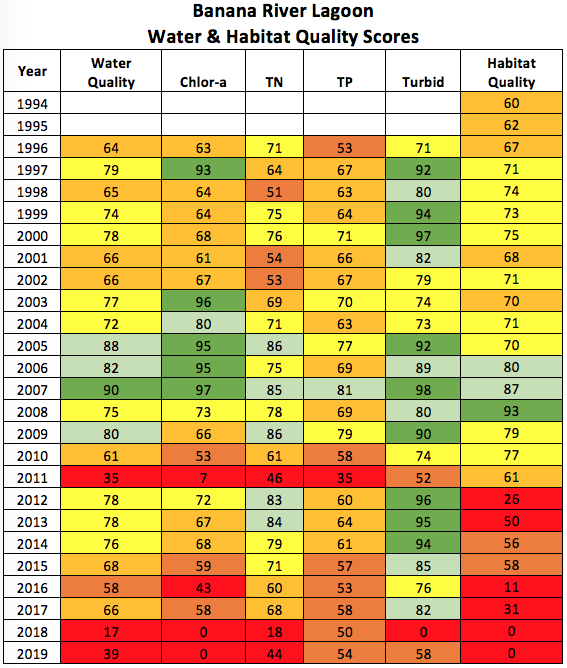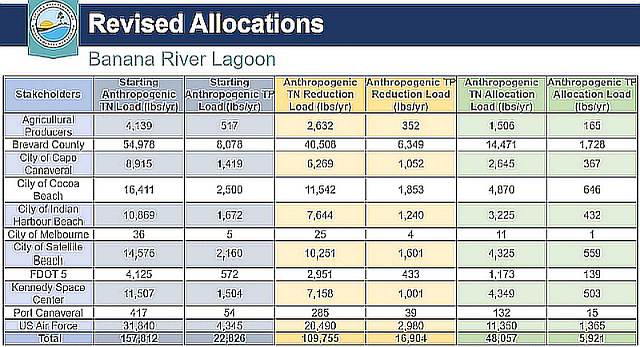Banana River Water Quality: Difference between revisions
mNo edit summary |
|||
| Line 2: | Line 2: | ||
{{IRL_header_estuary|cat=Banana River}} | {{IRL_header_estuary|cat=Banana River}} | ||
<div class="irlcontenttop"> | <div class="irlcontenttop"> | ||
Urbanized North Banana River suffers from excessive [[Nutrient Pollution|nutrient pollution]] caused by stormwater laden with lawn fertilizer, sewer seepage, and pet poop | Urbanized North Banana River suffers from excessive [[Nutrient Pollution|nutrient pollution]] caused by stormwater laden with lawn fertilizer, sewer seepage, and pet poop. | ||
Banana River suffered from a major algae bloom in 2011, and brown tide in 2016. | |||
</div> | |||
<div class="irlcontentmiddle"> | |||
==Banana River Health Report== | |||
Marine Resources Council performs an annual review of the Indian River Lagoon estuary's water data in order to publish the IRL Report Card. Rating several water quality factors on a scale of 0-100 resulted in the Banana River scoring less than 60 in December, 2020. Banana River lagoon has been in a steady decline since 2015. | |||
[[File:Banana_River_Lagoon_Water_Quality_Scores_2020.png|640px|thumb|left|MRC Banana River Water Quality Report 2020]] | |||
</div> | |||
<div class="irlcontentmiddle"> | |||
==Water Quality Pattern== | ==Water Quality Pattern== | ||
Like the entire IRL estuary, the Banana River's water quality varies with seasonal influences. | |||
'''April - June''' | '''April - June''' | ||
| Line 11: | Line 21: | ||
'''June - September''' | '''June - September''' | ||
* | |||
*Water becomes pea soup green as algae thrives on the excess nutrients, creating massive blooms that block sunlight from the seagrass. | |||
*Decomposition of | *Decomposition of seagrass and algae consumes the water's oxygen and kills marine life. | ||
*Protein molecules decomposing algae, seagrass and | *Protein molecules decomposing algae, seagrass and marine life are attracted to both water and air, and when agitated by wind, create a smelly, dark foam on the lagoon's surface and shorelines. | ||
'''October - December''' | '''October - December''' | ||
| Line 26: | Line 36: | ||
</div> | </div> | ||
<div class="irlcontentmiddle"> | <div class="irlcontentmiddle"> | ||
==Water Quality Standards== | ==Water Quality Standards== | ||
Florida Department of Environmental Protection (DEP) has determined that seagrass is the key indicator species representing the health of the lagoon's water. | Florida Department of Environmental Protection (DEP) has determined that seagrass is the key indicator species representing the health of the lagoon's water. | ||
Seagrass provides habitat for shrimp, clam, and crab, these species feed fish that are using the seagrass flats as a nursery. | Seagrass provides habitat for shrimp, clam, and crab, in turn, these species feed fish that are using the seagrass flats as a nursery. Without seagrass there is no next generation of marine life in the lagoon. | ||
Without seagrass there is no next generation of marine life in the lagoon. | |||
</div> | </div> | ||
<div | <div class="irlcontentmiddle"> | ||
===Banana River Nutrient Load=== | ===Banana River Nutrient Load=== | ||
| Line 42: | Line 49: | ||
[[File:DEP_BMAP_allocations_2020_Banana_River_Lagoon.jpg|640px|thumb|left|'''Banana River Nutrient Allocations:''' Gray=Current Load; Yellow=Required Reduction; Green=Allowed Load]] | [[File:DEP_BMAP_allocations_2020_Banana_River_Lagoon.jpg|640px|thumb|left|'''Banana River Nutrient Allocations:''' Gray=Current Load; Yellow=Required Reduction; Green=Allowed Load]] | ||
</div> | |||
<div class="irlcontentbottom"> | |||
==Web Links== | |||
*[https://savetheirl.org/irl-health-update/irl-report-card/ Marine Resources Council IRL Health Update] | |||
*[https://fdep.maps.arcgis.com/apps/MapSeries/index.html?appid=3113f204a7814a228f0b052262562d01 Banana River Lagoon Basin Management Action Plan Story Map] | |||
==Documents== | |||
*[https://floridadep.gov/sites/default/files/banana-river-lagoon-bmap.pdf DEP Banana River Lagoon BMAP 2013 (PDF 90pp 1.49MB)] | |||
</div> | </div> | ||
{{IRL footer estuary|cat=Banana River}} | {{IRL footer estuary|cat=Banana River}} | ||
</div> | </div> | ||
Revision as of 06:30, January 7, 2021
Urbanized North Banana River suffers from excessive nutrient pollution caused by stormwater laden with lawn fertilizer, sewer seepage, and pet poop.
Banana River suffered from a major algae bloom in 2011, and brown tide in 2016.
Banana River Health Report
Marine Resources Council performs an annual review of the Indian River Lagoon estuary's water data in order to publish the IRL Report Card. Rating several water quality factors on a scale of 0-100 resulted in the Banana River scoring less than 60 in December, 2020. Banana River lagoon has been in a steady decline since 2015.
Water Quality Pattern
Like the entire IRL estuary, the Banana River's water quality varies with seasonal influences.
April - June
- Summer rains bring nutrient laden stormwater into the lagoon.
- Water clarity declines.
June - September
- Water becomes pea soup green as algae thrives on the excess nutrients, creating massive blooms that block sunlight from the seagrass.
- Decomposition of seagrass and algae consumes the water's oxygen and kills marine life.
- Protein molecules decomposing algae, seagrass and marine life are attracted to both water and air, and when agitated by wind, create a smelly, dark foam on the lagoon's surface and shorelines.
October - December
- Summer rain's end, cooler temperatures, and winds disperse the biological mass. Much of it settles to the bottom creating slimy, black muck.
- Water is murky brown with very low clarity.
- Oxygen and salinity levels improve.
January - March
- Water clears up revealing a lifeless, barren desert below.
- Manatees move into the lagoon's warm water and graze on the remaining seagrass.
Water Quality Standards
Florida Department of Environmental Protection (DEP) has determined that seagrass is the key indicator species representing the health of the lagoon's water.
Seagrass provides habitat for shrimp, clam, and crab, in turn, these species feed fish that are using the seagrass flats as a nursery. Without seagrass there is no next generation of marine life in the lagoon.
Banana River Nutrient Load
DEP has revised the Banana River nutrient load allocations for the 2021 Basin Management Action Plan (BMAP) update.
Local municipalities will be asked to reduce Nitrogen (N) and Phosphorus (P) loads to a level that sustains healthy seagrass growth.


